By Edith Friesen for Enlivening Edge Magazine
Frederic Laloux’s original Reinventing Organizations book catalysed a vibrant global ecosystem of organizations inspired by the next stage of human consciousness. Enlivening Edge, as a part of this effervescence, is welcoming warmly the new version of the RO book, subtitled “An Illustrated Invitation to Join the Conversation on Next-Stage Organizations” that will be published this Summer.
Frederic kindly sent us an advance copy of the book that we could “review.” We, the team at EE, thoughtfully concluded that this re-envisioned book, called us to more than a book “review.” We took up the invitation in its subtitle to open a conversation with you, our readers—as part of the global conversation already taking place about RO, a conversation sure to be amplified greatly by this “illustrated invitation.”
We each let our attention be grabbed by a page with an image which evoked something energizing. For each, the image was frequently related to a creative tension we’re experiencing in our work between what’s happening in EE and what we could do better. May this article inspire you to use the book for taking your organisational life to the next level!
Let’s have a look at the illustrations the members of the Enlivening Edge team selected from the book, and what was evoked by the images:
About that wordsmithing illustration…
“Propped up in bed, I am reading the advance copy of the illustrated Reinventing Organizations, when a small illustration in the lower right corner of page 72 hits me between the eyes.
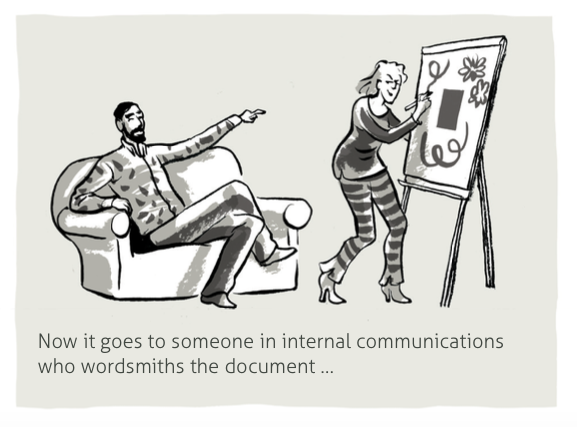
It is the word “wordsmithing” that hits me between the eyes. This surprises me, and maybe you, too. It reminds me of what I hate about traditional organizations. You see, I rose through the hierarchical ranks of organizations. I served in internal communications roles and functioned as a cog. I reported to pointy-armed men (and women).
But it’s wordsmithing that really gets me going. It feels too technical, rational, and craft-driven. It’s about adding, subtracting, finessing, and dressing things up to make them palatable and powerful. It comes from an instrumentalist, achievement-oriented worldview with a manipulative edge. And, yes, I was good at that.
Worse, it feels siloed and disconnected. Wordsmithing is unhooked from the act of creation and co-creation, both through time and through layers of organization. It comes later in the process.
Does it have to be this way?
In the next-stage organization of my dreams (and I must admit that EE comes pretty close), I bring my whole self to work, not just my rational, wordsmith-ready mind. I dance with colleagues in the place where an idea emerges from the froth, and before it puts on the garment of language.
And I dance with my colleagues in the place where the garment of words is tailored to reflect the underlying essence of the idea. If this sounds intuitive or spiritual, it probably is. In this dance, we feel into the deeper essence of idea and words until they match. Until it feels complete.
If you think this is airy-fairy, it isn’t. My colleague, Eric Babinet (who energizes the roles of Business Steward and Holacracy Coach at EE) and I recently worked this way. Of course, we had to leave our egos at the door and trust each other.
Since we live half a continent apart, it made sense to collaborate using Skype and GoogleDocs in real time. This let us see, feel, and hear each other (plus the space between us) as well as the words on the page. We toggled back and forth between the essence and the words until the statement we were working on felt, looked, and sounded complete. It didn’t take long at all. And it wasn’t wordsmithing.
I don’t have a better word. Yet. In fact, I long for this reinventing movement to sweep into the world of words and create better ones. Oh, right. That means people like you and me.” — by Edith Friesen
Working in a hammock
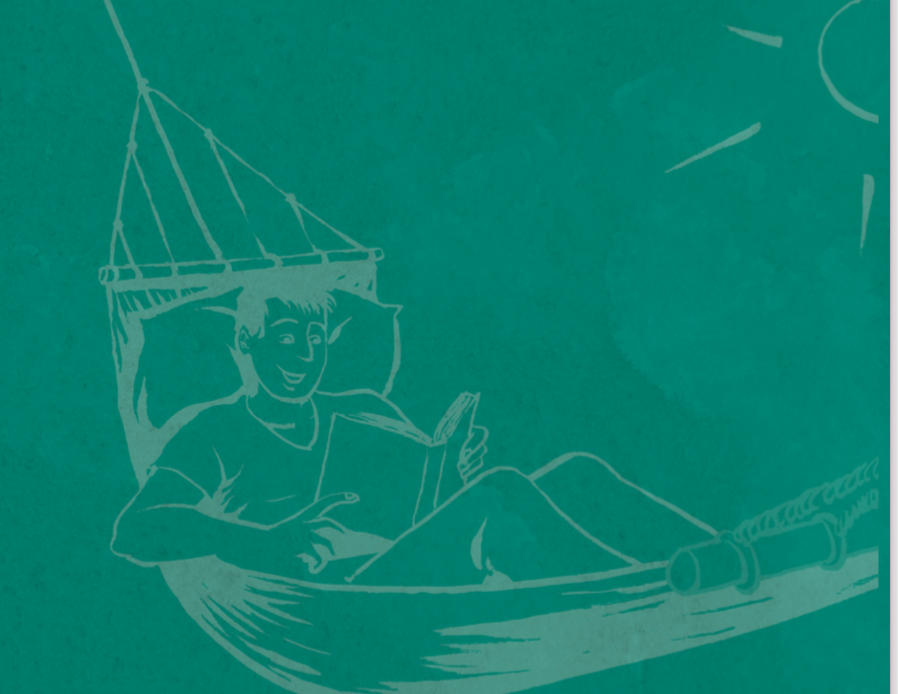
“Already something deep within me has shifted, and I’m only on the page between the table of contents and the introduction!
That page shows a fellow in a hammock, smiling and looking at a book. It viscerally knocked out of me, the taking for granted in my work life, of an undercurrent of anxiety and tenseness. It brought into my body-mind, a new felt-sense: my worklife if I were that fellow, feeling safe, supported, relaxed, eager, happy. Peaceful, and ready to dive in and move forward.
Thank you, Frederic Laloux and Etienne, and everyone else involved in producing this astonishing book!” — Lia Aurami
Abolishing the tyranny of “sense and respond”
“In the late 20th Century, in face of galloping complexity, the ‘strategic planning’ habits of management became largely useless. The new mantra of business schools and consultants for increased competitiveness became ‘Sense & Respond,’ as illustrated by a book of the Harvard Business School Press published under the same title in 1998.
The half-digested ideas of self-management and Holacracy’s dynamic steering have put “sense and respond” on the throne, exiling any long-term thinking into the wilderness of uncool. It was very refreshing to read in Laloux’s illustrated RO book:
Should we ban strategic thinking then?
‘Some organizations I’ve researched have never done a big strategic exercise. Sensing and responding on a daily basis does its magic. But it would be stupid to go overboard and say it should never be done. Sometimes a sudden change in the outside world requires a profound reflection about the future, leading to some big strategic decisions.
So, how then could those decisions be prepared?
I love the picture above that illustrates how collective deliberations may result in a jointly-put-together jigsaw of the future. It already makes me think of how we, in Enlivening Edge, could evolve some strategic thinking for embodying our essence more fully: Nourishing the conscious evolution of people, organizations, and social systems.” — George Pór
On the other side of complexity there is a simpler way—can we meet there?
“I am one of those who have read the original 360-page version a couple of times and loved it the way it is. As I was re-reading, in this new shorter and illustrated version, some of the evocative organisational vignettes, once again they brought tears to my eyes. In the last section, the hungry action-researcher in me found new nourishment in the additional perspective Frederic Laloux is able to offer on the still very open question of how to ‘go teal’. My reading culminated right at the end of the new book with the illustration and headline that produced the strongest creative tension for me, stating: There is a simpler way…
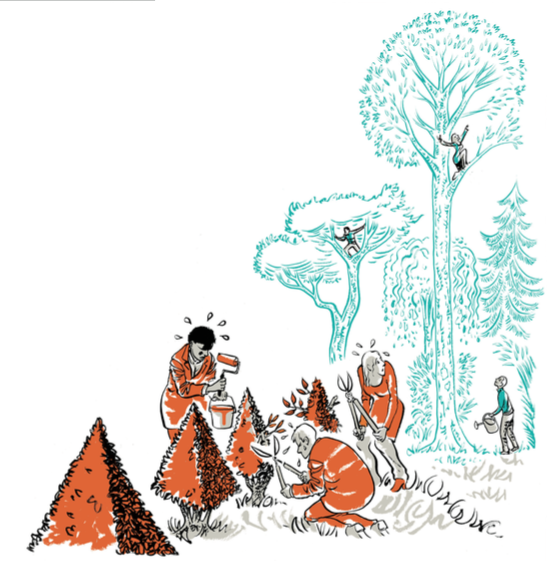
I was reminded how I recently heard Jos de Blok talk about the story of Buurtzorg—and how simple and fun he made it all sound. I realized how often I become overwhelmed with the complexity of the different perspectives and possibilities in my work, and the multiple interrelationships and connections, etc. How I strive to comprehend and hold it all consciously with my intellect— and how that sometimes immobilizes me.
That contrasts with the times where I feel in flow, where seemingly effortlessly one step leads to the next and I just trust the people and the process involved, the unconscious or collective intelligence or whatever it is that leading me and others in this space. In the two months that I have so far been engaged with Enlivening Edge, I have had a lot of such flowful experiences. I feel that these have been supported by the trust, authenticity, and mutual interest present in interactions with my colleagues, complemented by a simple ‘next step’ action focus.
Yet, the illustration and invitation to a simpler way sparked at least two creative tensions for me. The first relates to my current involvement in a re-visioning exercise for how Enlivening Edge may develop as an experiential community platform in the future. This quickly risks becoming anything but simple, if I and we go too far in our mental constructions of how this might be organized. So what is the simple way forward here?
The second tension involves how we use Holacracy in Enlivening Edge. With my only two-month experience, the Holacratic prescriptions still seem to me a bit clunky, and ‘overly formalized’ with respect to constitutional rights and duties and prescriptions of what is allowed and what is not. I also wonder if there are still too many ‘powers’ retained by the lead-link role (e.g. appointing/removing people to/from roles) to fully release the self-organizing potential?
So far Holacracy has not felt for me quite like ‘the simple way’ but also not overly constraining. Perhaps with time it will feel simple. Perhaps for now just knowing that there is an underlying constitutionally-secured order (even though I haven’t internalized what it is yet) is comforting the order-loving and anti-authoritarian parts of me/us—so they don’t get in the way of the simpler free-flowing way? I’ll be sure to keep an eye on that going forward.” — Bjørn Uldall
Leaving weapons at the door, being real and vulnerable
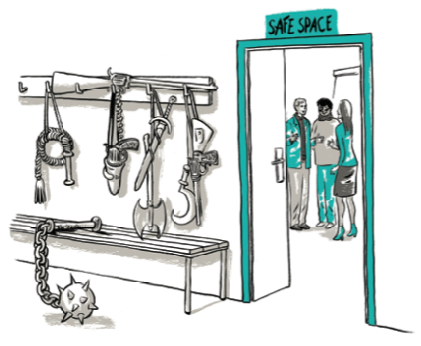
“On the surface level this image depicts the necessity for safe spaces in organisations where we leave our weapons at the door. The text speaks of the need to go beyond lip service to values by creating specific ground rules for ‘behaviors colleagues wish to see, and what behaviors are deemed unacceptable.’
However I found this image extremely evocative in that it brings up an even subtler meaning for me. In our work and deliberations for Enlivening Edge we are called into operating from the Teal level of consciousness. Letting go of the ‘shoulds’, all of the conditioning, and learning to navigate the energy that wants to move through me—rather than conforming to preconceptions of what I feel is expected of me—has been and still is a challenging journey.
In our evolution, humanity has resorted to using weapons as a means of countering our vulnerability. Rest assured there’s no aggression in the EE team; they’re really a very friendly bunch! But we’ve learned in our deliberations that it’s necessary to let go of our armoury and be real with each other about what we want or perceive.
The journey into Teal is the journey out of ego and fear. Allowing myself to fully be me and find my unique contribution to the team contrasts with a lifetime of structures where I had to be a square peg in a round hole. In EE those old structures don’t exist, and the protective weaponry isn’t needed. Letting go of them is a journey.” — Andy Paice
Visceral symbols of the old and new live inside me
“Reading through this morning I am struck by how well the book translates into this format, and how much of a leap forward the material takes having been written with the illustrations in mind. They make the content feel visceral (the giant red-swathed fellow with the club is one of my favorites…!) and are enjoyable on their own accord.
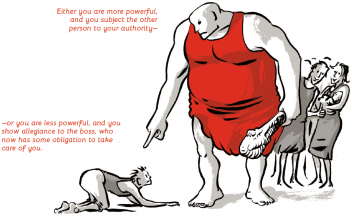
In fact, about that red giant… there’s something about the visceral and symbolic nature of image that can speak so much more deeply to us than words alone. Who doesn’t see that red bully and immediately feel the emotions from that time in the school yard, the field, the board room? We need so much more than language, as rich as it is. We need to feel the world we want to create, deeply inside us. We need to feel also what no longer works, what keeps us small. That’s what happens to me looking through this new version of the book… the material lives inside me in a new way. And that is yet another evolutionary step.” — Chris Clark
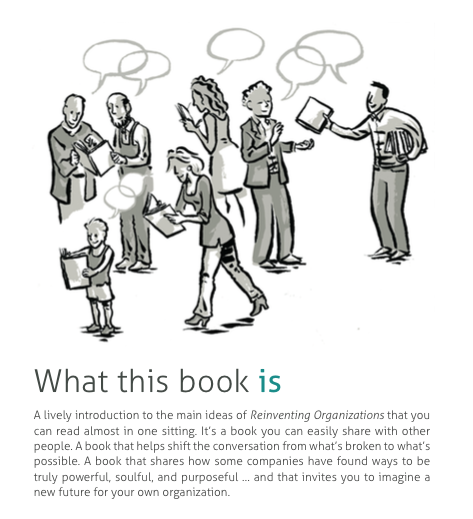
The book will be published really soon; watch this space for the announcement and be among the first to know when it is available. All you have to do is enter your email address in the field under “GET EVERY NEW POST when they appear!” in the upper right corner of any EE page.
When it is out, get yourself a copy, spread the word, and be ready to enjoy its many delightful surprises.
After you have a chance to read the book, please do come back here and share your own reflections and questions below, in the comments section of this page.
We’d love to hear what stories and images will be inspiring and moving you to do something in your organization differently!
Updated on June 28, 2016: The illustrated version, along with the audiobook, has just become available! After reading it, please come back here to share your reflections with other readers.
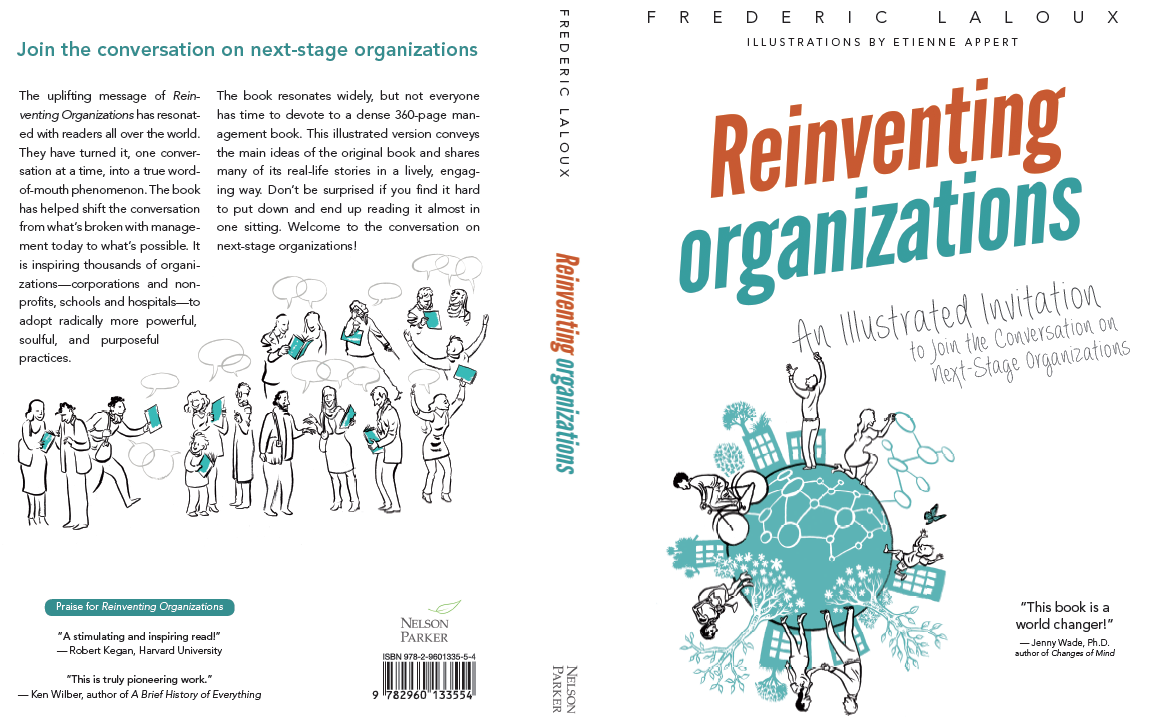
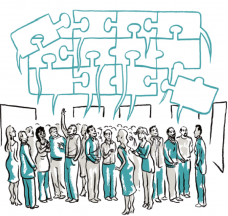


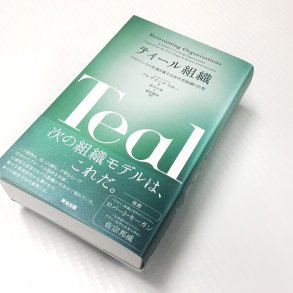
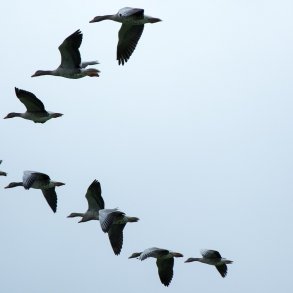
I already finished the original “classic” book, but I feel the urge to read it all over again.
As a co-founder of a company there are so many things I can relate to, things that are now hitting hard in my head, things that makes perfect sense to me because we are so far from teal they are so obvious. Now I can’t see The World with the same glasses I used to.
I want to get the Illustrated version as soon as being published, I want to get a lot of inspiration to communicate these ideas to others in a more digestable but at the same time comprehensive way. Perhaps the next step would be to create some short animations to engage a broader audience and I’d be more than willing to help with this.
—Armando Ricalde
Just making note of some typos:
” I also wonder if there are still to many ‘powers’ ” -> “too many”
“Holacracy has not feltfor” -> “felt for”
Wow, Armando, great suggestion, short animations, and you are more than willing to help! Wondrous! Be sure to suggest that directly to Frederic on his website.
Fixed those typos and others I found, thanks! 🙂
Alia, these are the things that truly makes you want to do something about it, I feel the urge to communicate and inspire as much folks as I can about RO.
I’ll contact Frederic, thanks,
Querido Armando, let’s talk about animating a few episodes of the book.
The viewers of the soon coming Enlivening Edge TV would be delighted to watch your RO animations!
Sure George 🙂
I don’t entirely share your objection to “wordsmith”. This has a fairly honourable heritage and shares it’s etymology with goldsmith, silversmith and blacksmith, all worthy crafts – which like all crafts can be misused as likewise the skills of the smith used for unhelpful purposes.
Perhaps they know not what they do?
Thanks so much for your response, William. Yes, I agree, wordsmithing has an honourable heritage. However, there may be better metaphors, metaphors that come from a deeper place, that tap into a sense of aliveness. Metaphors that speak about one’s relationship with writing, and about revising from the inside out. I am currently reading “Ensouling Language: the art of nonfiction and the writer’s life” (a delicious book that I cannot recommend highly enough) and am realizing , once again, that metaphors matter. There are so many wonderful gems in this book. Here is just one about the process of editing. “In the process of feeling into and loving each section, every word in the text, what you have made will become fully inhabited. from directed eros energy a soul force begins to move inside every part of the manuscript, a dark well of psychic energy begins to flow into every word.” (p. 260) This feels to me more organic, less dry and technical than wordsmithing. It feels, somehow, more whole, more true to the way I edit. What is your sense?